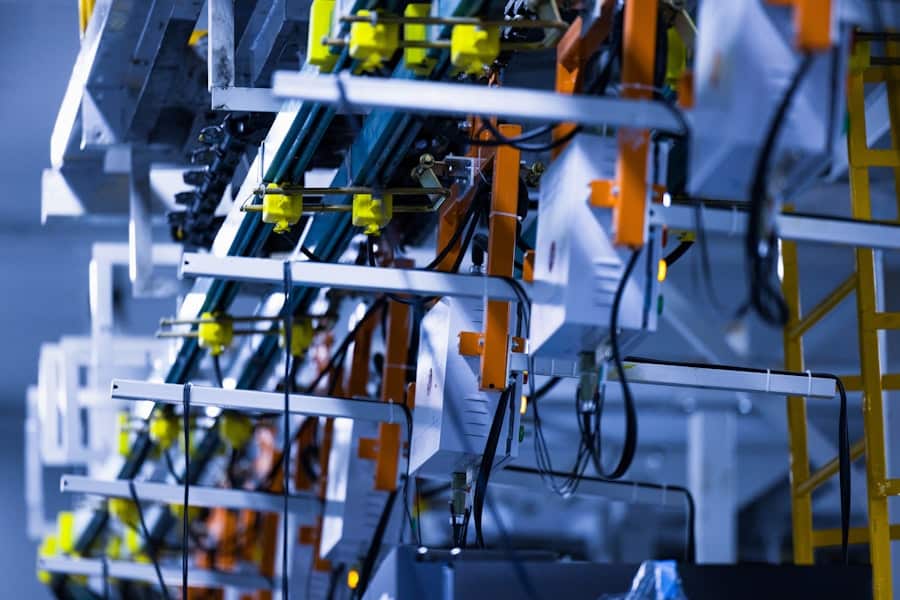The landscape of manufacturing has undergone a seismic shift over the past few decades, primarily driven by the advent of automation technologies. Automation in manufacturing refers to the use of control systems, such as computers or robots, for handling different processes and machinery in an industry to replace human intervention. This transformation is not merely a trend; it represents a fundamental change in how products are designed, produced, and delivered.
As industries strive for greater efficiency and competitiveness, automation has emerged as a critical enabler. The rise of Industry 4.0, characterized by the Internet of Things (IoT), artificial intelligence (AI), and advanced robotics, has further accelerated this trend.
Manufacturers are increasingly adopting automated solutions to optimize their operations, reduce costs, and improve product quality. This article delves into the multifaceted benefits of automation in manufacturing, exploring its implications for productivity, efficiency, workforce dynamics, and future trends.
Key Takeaways
- Automation in manufacturing refers to the use of technology and machinery to perform tasks with minimal human intervention.
- Manufacturers can benefit from automation through increased productivity, improved quality, reduced labor costs, and enhanced safety.
- Robotics play a crucial role in automated manufacturing by performing repetitive tasks with precision and efficiency.
- Automation can significantly impact efficiency and productivity by streamlining processes, reducing errors, and increasing output.
- Addressing the skills gap in manufacturing can be achieved through automation by retraining workers for higher-skilled roles and leveraging technology for complex tasks.
The Benefits of Automation for Manufacturers
One of the most significant advantages of automation in manufacturing is the substantial reduction in operational costs. By automating repetitive tasks, companies can minimize labor expenses and reduce the likelihood of human error. For instance, a study by McKinsey & Company found that automation could potentially reduce labor costs by up to 30% in certain manufacturing sectors.
This cost efficiency allows manufacturers to allocate resources more strategically, investing in innovation and development rather than merely maintaining labor-intensive processes.
Automated systems can perform tasks with precision that far exceeds human capabilities.
For example, in the automotive industry, robotic arms are employed for welding and painting vehicles, ensuring uniformity and reducing defects. This level of accuracy not only improves the final product but also enhances customer satisfaction and brand loyalty. As manufacturers strive to meet increasingly stringent quality standards, automation becomes an indispensable tool for maintaining competitive advantage.
The Role of Robotics in Automated Manufacturing

Robotics plays a pivotal role in the realm of automated manufacturing, serving as the backbone of many modern production lines. Industrial robots are designed to perform specific tasks with high efficiency and reliability. These machines can operate continuously without fatigue, making them ideal for high-volume production environments.
For instance, companies like FANUC and KUKA have developed advanced robotic systems that can handle everything from assembly to packaging with remarkable speed and accuracy. The versatility of robotics is another key factor contributing to their widespread adoption in manufacturing. Robots can be programmed to perform a variety of tasks, allowing manufacturers to adapt quickly to changing production needs.
In the electronics sector, for example, robotic systems are used for assembling intricate components with precision that would be challenging for human workers. This adaptability not only streamlines production processes but also enables manufacturers to respond swiftly to market fluctuations and consumer demands.
The Impact of Automation on Efficiency and Productivity
The implementation of automation technologies has a profound impact on overall efficiency and productivity within manufacturing environments. Automated systems can operate around the clock without breaks, significantly increasing output levels compared to traditional manual labor. For instance, a fully automated assembly line can produce thousands of units per hour, whereas a manual line may struggle to meet even half that output due to human limitations.
Furthermore, automation facilitates better resource management. By utilizing advanced software solutions that integrate with automated machinery, manufacturers can monitor production processes in real-time, identifying bottlenecks and inefficiencies as they arise. This data-driven approach allows for continuous improvement initiatives that enhance productivity over time.
Companies like Siemens have successfully implemented such systems in their factories, resulting in increased throughput and reduced waste.
Addressing the Skills Gap with Automation
While automation offers numerous benefits, it also presents challenges related to the skills gap in the workforce. As manufacturing processes become increasingly automated, there is a growing demand for skilled workers who can operate and maintain these advanced systems. Unfortunately, many existing workers may lack the necessary training or education to thrive in this new environment.
This skills gap poses a significant barrier to successful automation adoption. To address this issue, manufacturers must invest in workforce development initiatives that equip employees with the skills needed for an automated future. This includes providing training programs focused on robotics operation, programming, and maintenance.
Companies like General Electric have taken proactive steps by partnering with educational institutions to create specialized training programs aimed at bridging this skills gap. By fostering a culture of continuous learning and development, manufacturers can ensure that their workforce is prepared to embrace automation rather than fear it.
The Importance of Data and Analytics in Automated Manufacturing

In an era where data is often referred to as the new oil, its significance in automated manufacturing cannot be overstated. Automation generates vast amounts of data from various sources within the production process, including machinery performance metrics, supply chain information, and customer feedback. Leveraging this data through advanced analytics allows manufacturers to gain valuable insights into their operations.
For instance, predictive analytics can help manufacturers anticipate equipment failures before they occur, minimizing downtime and maintenance costs. By analyzing historical data patterns, companies can identify trends that inform decision-making processes related to production scheduling and inventory management. Organizations like Bosch have successfully implemented data analytics solutions that enable real-time monitoring of their manufacturing operations, leading to improved efficiency and reduced operational costs.
Overcoming Challenges and Barriers to Automation Adoption
Despite the clear advantages of automation in manufacturing, several challenges hinder its widespread adoption. One significant barrier is the initial investment required for implementing automated systems. The cost of purchasing advanced machinery and integrating it into existing workflows can be daunting for many manufacturers, particularly small and medium-sized enterprises (SMEs).
Additionally, concerns about return on investment (ROI) may lead some companies to hesitate before making such substantial financial commitments. Another challenge lies in the cultural resistance to change within organizations. Employees may fear job displacement due to automation or feel overwhelmed by the prospect of adapting to new technologies.
To overcome these barriers, manufacturers must engage in transparent communication with their workforce about the benefits of automation and how it can enhance rather than replace human roles. By fostering a collaborative environment where employees are involved in the transition process, companies can mitigate resistance and encourage a smoother integration of automated solutions.
The Future of Manufacturing: Embracing Automation for Success
Looking ahead, the future of manufacturing is poised to be heavily influenced by continued advancements in automation technology. As artificial intelligence and machine learning become more sophisticated, manufacturers will have access to even more powerful tools for optimizing their operations. The integration of smart factories—where machines communicate with each other and make autonomous decisions—will redefine traditional manufacturing paradigms.
Moreover, sustainability will play an increasingly vital role in shaping the future of automated manufacturing. As environmental concerns grow, manufacturers will need to adopt practices that minimize waste and energy consumption while maximizing efficiency. Automation can facilitate this transition by enabling more precise resource management and reducing the carbon footprint associated with production processes.
In conclusion, embracing automation is not merely an option for manufacturers; it is becoming a necessity for survival in an increasingly competitive global market. By leveraging the benefits of automation—ranging from enhanced efficiency and productivity to improved product quality—manufacturers can position themselves for long-term success while addressing challenges such as workforce development and cultural resistance. As technology continues to evolve, those who adapt will thrive in the new era of manufacturing.
In the rapidly evolving landscape of manufacturing, automation stands as a pivotal force driving efficiency and innovation. As industries increasingly integrate advanced technologies, the importance of selecting the right tools and software becomes paramount. An article that complements the discussion on automation in manufacturing is Best Software for House Plans. While it focuses on architectural design, the underlying theme of leveraging software to enhance productivity and precision is a shared narrative. Just as automation streamlines manufacturing processes, the right software can revolutionize how architects and builders conceptualize and execute their projects, underscoring the transformative power of technology across various sectors.
FAQs
What is automation in manufacturing?
Automation in manufacturing refers to the use of technology and machinery to perform tasks that were previously carried out by humans. This can include processes such as assembly, packaging, and quality control.
Why is automation crucial for the future of manufacturing?
Automation is crucial for the future of manufacturing because it can increase efficiency, reduce costs, improve quality, and enhance safety in the production process. It also allows for greater flexibility and scalability in manufacturing operations.
What are the benefits of automation in manufacturing?
Some of the benefits of automation in manufacturing include increased productivity, reduced labor costs, improved product quality, faster production cycles, and the ability to handle complex tasks with precision.
What are some examples of automation in manufacturing?
Examples of automation in manufacturing include robotic arms for assembly, conveyor belts for material handling, CNC machines for precision machining, and automated inspection systems for quality control.
What are the challenges of implementing automation in manufacturing?
Challenges of implementing automation in manufacturing can include high initial investment costs, the need for specialized technical expertise, potential job displacement, and the need to integrate new technologies with existing systems.

